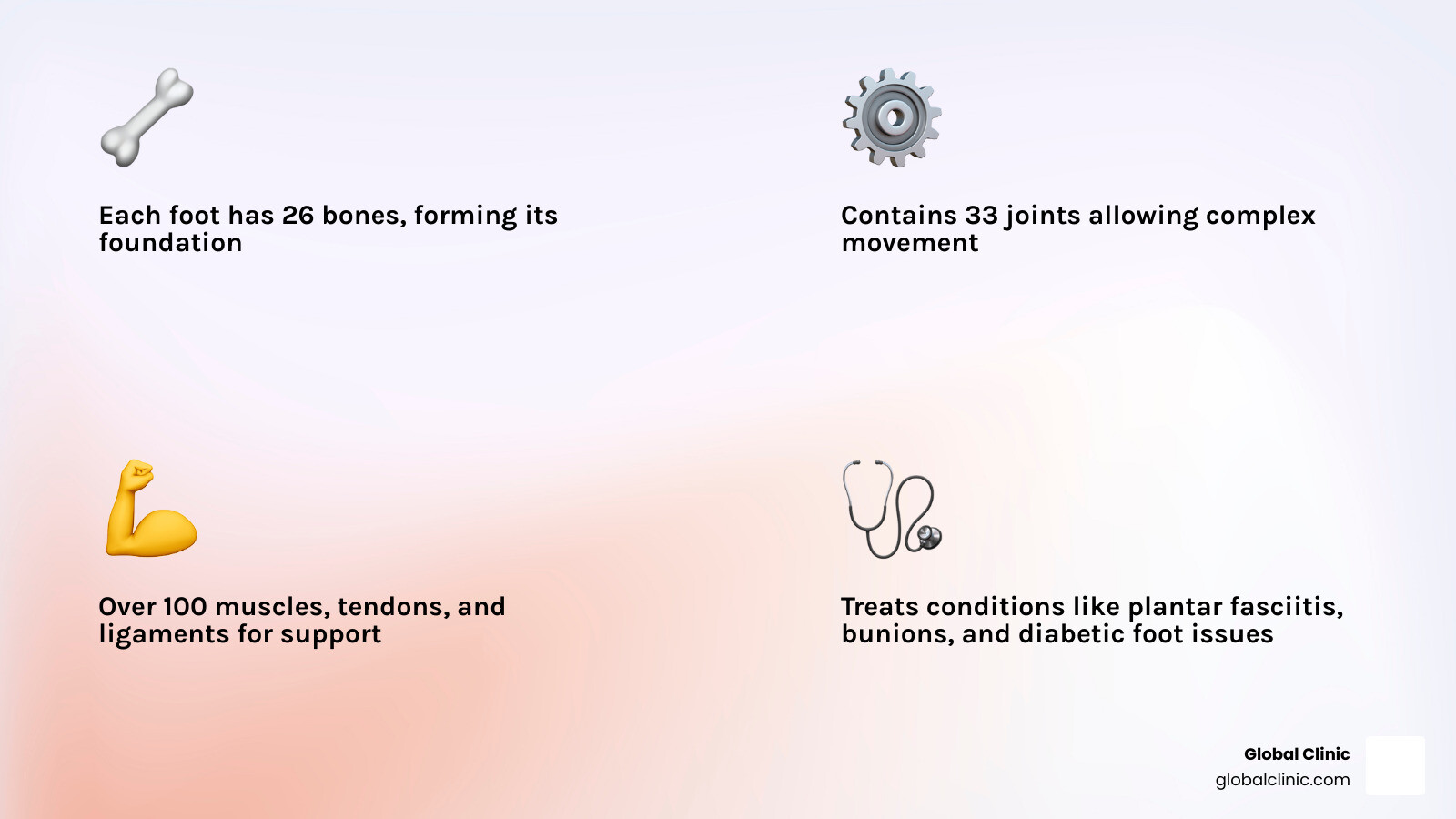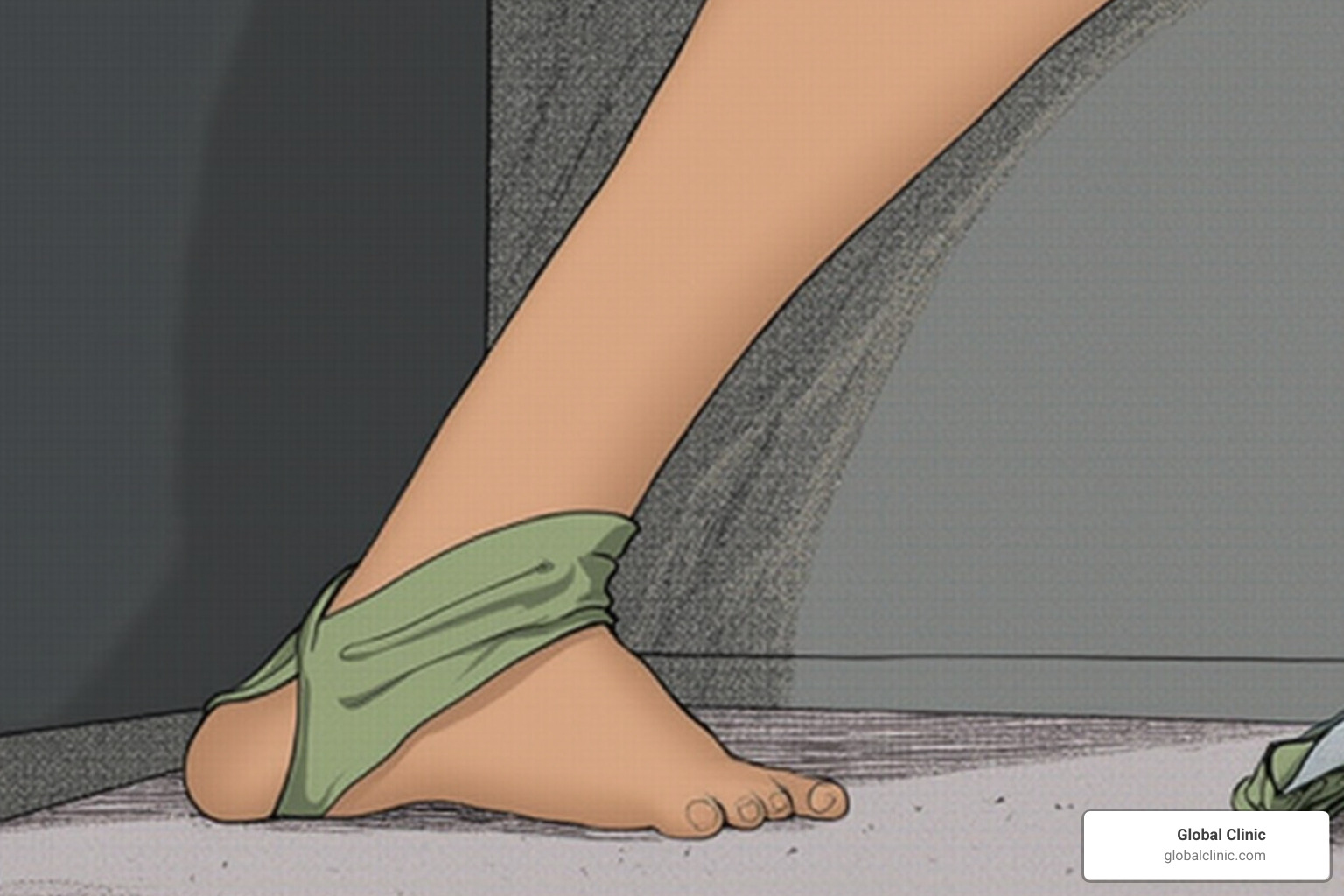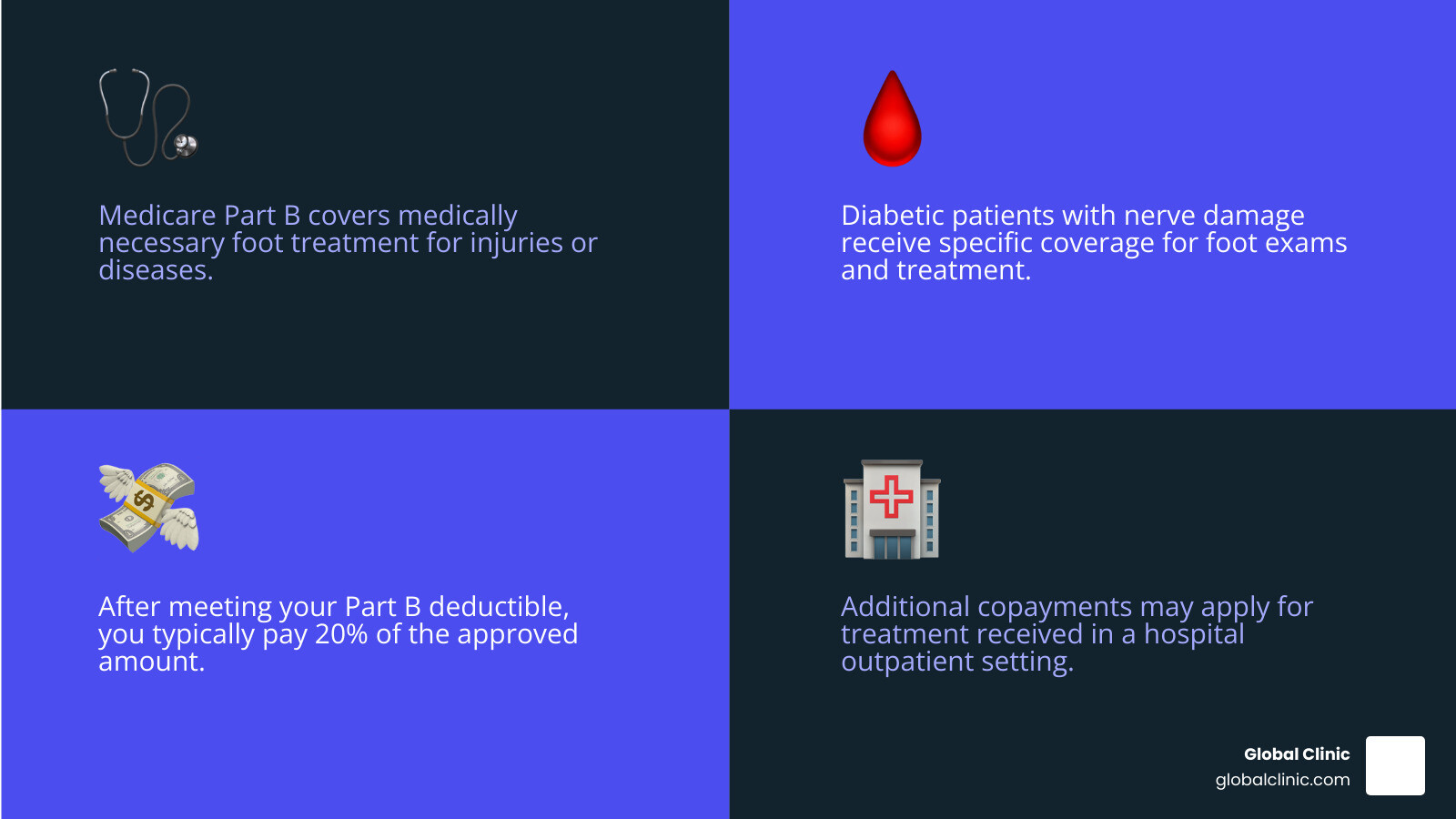Why Finding the Right Foot Doctor Can Transform Your Life
A foot doctor is your pathway to pain-free mobility and better overall health. Whether you’re dealing with heel pain, ankle injuries, or chronic conditions like diabetes-related foot problems, the right specialist can make all the difference.
Quick Answer: What is a Foot Doctor?
- Primary Type: Podiatrist (Doctor of Podiatric Medicine – DPM)
- Specializes In: Foot, ankle, and lower leg conditions
- Training: 4 years podiatric medical school + 3-4 year residency
- Services: Diagnosis, treatment, surgery, custom orthotics, wound care
- When to See One: Persistent pain, swelling, numbness, walking difficulties
Your feet are the foundation of your entire body. With 26 bones, 33 joints, and over 100 muscles, tendons, and ligaments packed into each foot, it’s no wonder that foot problems can quickly spiral into issues affecting your knees, hips, and back. When foot pain strikes, it doesn’t just hurt – it can stop you in your tracks and dramatically impact your quality of life.
The good news? You don’t have to live with foot pain. Modern podiatric medicine offers both surgical and non-surgical solutions for virtually every foot and ankle condition imaginable. From common issues like plantar fasciitis and bunions to complex diabetic wound care and reconstructive surgery, today’s foot doctors have the training and tools to get you back on your feet.
I’m Ana Vinikov, Practice Manager at Global Clinic, where I’ve spent years helping patients in Northern Chicago find the right foot doctor for their specific needs. Through our multidisciplinary approach combining podiatric care, pain management, and regenerative medicine, I’ve seen how the right specialist can transform someone’s life.

Who is a Foot Doctor? Understanding Your Options
When you hear the term foot doctor, you’re most often thinking of a podiatrist. A podiatrist is a highly trained medical professional, specifically a Doctor of Podiatric Medicine (DPM). Their entire focus is on your feet, ankles, and the related structures in your lower legs. They are the experts in diagnosing, treating, and even performing surgery for any condition affecting these vital parts of your body. Think of them as your go-to specialists for anything from the knee down!

Becoming a podiatrist involves a journey of extensive education and rigorous training, much like other medical doctors. It’s not a quick path! Here’s a peek at what it takes:
First, they complete four years of undergraduate studies, usually focusing on science. Then, it’s on to four years of accredited podiatric medical school, where they earn their Doctor of Podiatric Medicine (DPM) degree. This degree is the equivalent of an MD or DO, but with a specialized focus.
After medical school, future podiatrists dive into a three- or four-year hospital-based residency program. This is where they gain hands-on experience across a wide range of medical and surgical aspects of foot and ankle care. Some podiatrists even choose to pursue an extra year of fellowship training, specializing further in areas like reconstructive surgery, sports medicine, or wound care.
Finally, many podiatrists choose to become board-certified. This means they’ve passed rigorous exams from organizations like the American Board of Podiatric Medicine (ABPM) or the American Board of Foot and Ankle Surgery (ABFAS). It shows their deep commitment to top-notch care.
We invite you to learn about podiatric medical education to truly appreciate the demanding path these dedicated specialists undertake.
Podiatrist vs. Orthopedist
It’s very common for people to wonder about the difference between a podiatrist and an orthopedist. Both are incredibly skilled medical professionals who can help with issues in your lower body, but their training and primary areas of focus are different.
Here’s a clear comparison to help you understand your best options:
| Feature | Podiatrist (DPM) | Orthopedist (MD/DO) |
|---|---|---|
| Degree | Doctor of Podiatric Medicine (DPM) | Doctor of Medicine (MD) or Doctor of Osteopathy (DO) |
| Primary Scope of Practice | Specializes exclusively in the feet, ankles, and lower legs. | Specializes in the entire musculoskeletal system (bones, muscles, joints, soft tissues) throughout the body. |
| Typical Conditions Treated | Ingrown toenails, bunions, hammertoes, plantar fasciitis, diabetic foot care, foot fractures, ankle sprains, fungal infections, custom orthotics. | Fractures throughout the body, joint replacements (hip, knee, shoulder), spine conditions, sports injuries affecting various joints, some foot/ankle conditions. |
| When to Choose Each Specialist | For most conditions specifically affecting the feet, ankles, or lower legs; especially for common ailments, skin/nail issues, or diabetic foot complications. | For complex musculoskeletal issues that may extend beyond the foot/ankle, or for conditions requiring broader orthopedic expertise (e.g., severe ankle fractures requiring reconstruction that impacts knee or hip alignment, or if you have pain in multiple joints). |
While their focuses differ, there can be some overlap, especially when it comes to foot and ankle injuries or conditions like arthritis. Sometimes, patients find it beneficial to see both specialists for the most comprehensive care, as their expertise can truly complement each other. At Global Clinic, our team is here to guide you toward the most appropriate specialist for your unique needs, ensuring you get the right care every time.
When to See a Foot Doctor: Signs You Shouldn’t Ignore
Your feet carry you through thousands of steps every day, so when they start hurting, your body is trying to tell you something important. The tricky thing about foot pain is that many people assume it’s just part of life – something to grit your teeth and bear. But here’s the truth: persistent foot pain isn’t normal, and ignoring it can turn a small problem into a big one.
Persistent foot or ankle pain is probably the most obvious sign that it’s time to see a foot doctor. If you’ve been dealing with pain that doesn’t improve after a few days of rest, or if it gets worse when you’re active, your feet are asking for professional help. This could be anything from plantar fasciitis (that stabbing heel pain) to a stress fracture that’s not healing properly.
Swelling in your feet or ankles that doesn’t go away is another red flag. Your feet might puff up after a long day or a cross-country flight, but when swelling sticks around or appears without an obvious cause, it often signals injury, inflammation, or an underlying condition that needs attention.
Numbness or tingling sensations – that “pins and needles” feeling – can be particularly concerning. These symptoms often point to nerve damage or neuropathy, which is especially serious if you have diabetes. The good news is that early intervention can make a huge difference. If you’re experiencing chronic nerve-related pain, you might want to learn more info about Peripheral Nerve Stimulation for Treating Chronic Pain.
Don’t ignore changes to your skin or toenails either. Discoloration, persistent redness, unusual growths like warts, sores that won’t heal, or toenails that are thickening, crumbling, or changing color can all signal infections or other serious conditions that a foot doctor can properly diagnose and treat.
If you’re having difficulty walking or bearing weight – finding yourself limping, struggling to put weight on your foot, or noticing that your walking pattern has changed – it’s definitely time for a professional evaluation. These changes in how you move can stem from injuries, structural problems, or nerve issues that won’t resolve on their own.
Finally, an injury that doesn’t improve with rest deserves medical attention. The old RICE method (rest, ice, compression, elevation) can help with minor sprains and strains, but if you’re not seeing improvement after a few days to a week, there’s likely more going on than meets the eye.
Red Flag Symptoms That Require Immediate Attention:
- Sudden, severe pain or swelling
- An open wound or a wound that is red, warm, swollen, or draining pus (especially if you have diabetes)
- Inability to bear weight on your foot or ankle
- A foot or toe that looks deformed
- Numbness accompanied by changes in skin color or temperature

The bottom line? Your feet are incredibly complex structures with intricate networks of bones, muscles, and nerves. What seems like a minor issue can quickly escalate if left untreated. Don’t try to tough it out or diagnose yourself with Dr. Google. A timely visit to a foot doctor can prevent complications, relieve your pain, and get you back to doing the things you love – comfortably and confidently.
What Conditions Can a Foot Doctor Treat?
A foot doctor provides comprehensive care for the full spectrum of foot and ankle problems, from ingrown toenails to complex diabetic wound management. They offer both surgical and non-surgical solutions custom to your needs.
Podiatrists take a holistic approach, understanding that foot pain can be connected to your gait, footwear, or underlying health conditions. They don’t just treat symptoms; they address root causes with personalized treatment plans.
Common Ailments and Injuries
Many common conditions bring people to a podiatrist. Plantar fasciitis, an inflammation causing sharp heel pain, is a frequent complaint but is highly treatable.
Heel spurs, bony growths on the heel, often accompany plantar fasciitis and can cause significant discomfort. A foot doctor can help manage the pain and prevent complications.
Structural issues like bunions and hammertoes are more than cosmetic concerns; they can impact mobility. Bunions are the bump at the base of the big toe, while hammertoes are an abnormal bend in a toe joint. Early intervention is crucial as these can worsen over time.
Ingrown and fungal toenails may seem minor, but the pain and embarrassment they cause warrant professional attention.
For active individuals, ankle sprains (stretched or torn ligaments) and stress fractures (tiny cracks in bones) are common. Achilles tendonitis, inflammation of the tendon connecting the calf to the heel, can also sideline you if left untreated.
Chronic Conditions and Specialized Care
Beyond everyday injuries, foot doctors provide essential care for chronic conditions.
Foot and ankle arthritis can make simple activities painful. The inflammation and joint degeneration can fundamentally change how you move. If you have joint pain elsewhere, our guide on living comfortably with knee arthritis may offer helpful strategies.
Diabetic foot care is one of the most critical areas of podiatry. Diabetes can cause nerve damage and poor circulation, turning a minor cut into a serious infection. Regular podiatric care is essential for diabetic patients to prevent complications like amputation.
Neuropathy management addresses nerve damage from various conditions that cause numbness, tingling, or sharp pain. A foot doctor can identify the cause and create a plan to manage symptoms.
Wound and ulcer care for non-healing sores requires specialized techniques to promote healing and prevent infection.
In severe cases, the goal is limb preservation. Through aggressive, comprehensive care for diabetic complications or advanced infections, podiatrists help patients avoid amputation and maintain their independence.
Whether it’s a minor corn or a complex chronic condition, you don’t have to suffer. Today’s foot doctors have more tools than ever to help you live an active, comfortable life.
Your First Visit: What to Expect and How to Prepare
Visiting a new doctor can be nerve-wracking, but a trip to the foot doctor is the first step toward getting answers and feeling better.

At Global Clinic, we want you to feel comfortable and informed. Knowing what to expect can make your visit over our 20 years in Northern Chicago more relaxed and productive.
The Initial Consultation and What Your Foot Doctor Needs to Know
Your first appointment is a detailed conversation to solve the mystery of your foot pain.
Your medical history is the starting point. We’ll ask about your overall health, conditions like diabetes or arthritis, past surgeries, and current medications. Bringing a list of your medications is very helpful.
Next, you’ll discuss your symptoms and pain levels. Be ready to describe what you’re experiencing in detail: when the pain started, what it feels like (sharp, dull, etc.), and what makes it better or worse. The more details you provide, the better.
We’ll also ask about your lifestyle and daily habits. Your job, hobbies, exercise routine, and footwear all play a role in your foot health. These details help us understand the “why” behind your pain.
The physical examination is thorough but gentle. Your foot doctor will examine your feet and ankles, checking for swelling, tenderness, or structural issues. They may press on different areas or move your foot to pinpoint the problem.
One of the most revealing parts of the visit is the gait assessment—watching how you walk. Your walking pattern shows a lot about what’s happening with your feet and how your body is compensating for pain.
Diagnosis and Your Personalized Treatment Plan
After gathering information, we put the puzzle pieces together. Modern foot doctor offices like our state-of-the-art facility at Global Clinic can often provide answers on the spot.
On-site X-rays mean no extra appointments or waiting for results. We can take and review images of your bones during your visit. Ultrasounds help us see soft tissues like tendons and ligaments in real-time, which is useful for conditions like plantar fasciitis.
After your exam and any tests, your foot doctor will explain their findings in clear, jargon-free terms.
Your personalized treatment plan might include custom orthotics designed to correct imbalances and provide support. Physical therapy can strengthen muscles and improve flexibility to address the root cause of your pain.
For some conditions, we might discuss regenerative medicine options like PRP Injections, which use your body’s own healing power to repair damaged tissues.
You’ll leave with a clear understanding of what’s wrong, why it happened, and our plan to fix it together.
Frequently Asked Questions about Foot Doctors
It’s natural to have questions when considering seeing a foot doctor. Here are answers to some of the most common ones we hear at Global Clinic.
Can a foot doctor help with my knee, hip, or back pain?
Surprisingly, the answer is often yes. Your body is a connected system (the kinetic chain), and when your feet aren’t aligned properly, it creates a ripple effect. Misalignment from flat arches or an abnormal gait can strain your ankles, knees, hips, and spine.
For example, fallen arches can cause your knee to rotate inward, leading to pain. Poor foot alignment can also affect your posture, contributing to hip and back pain. Our guide on how to relieve knee pain offers related insights.
A foot doctor addresses these issues by diagnosing the root cause. By examining your foot structure and gait, they can identify how your feet contribute to pain elsewhere. Custom orthotics are often a game-changer, as these inserts correct biomechanical issues and reduce stress on your knees, hips, and back.
Proper gait correction through targeted therapy can also improve your walking pattern, relieving strain on other joints. By fixing the foundation, a podiatrist can help alleviate pain throughout your body.
Does Medicare cover visits to a foot doctor?
Yes, Medicare Part B covers visits to a foot doctor for treatment that is “medically necessary.” This includes care for foot injuries and diseases like bunions, hammertoes, and heel spurs, but not routine foot care.
Coverage includes medically necessary treatment for these conditions. For patients with diabetes-related nerve damage, Medicare Part B specifically covers podiatric exams and treatment, which is crucial for preventing serious complications.
Your out-of-pocket costs usually include the Part B deductible and 20% of the Medicare-approved amount. A hospital outpatient setting may have an additional copayment.

It’s wise to discuss estimated costs with your foot doctor’s office beforehand to understand what Medicare will cover and what your expenses might be.
Is a podiatrist a surgeon?
Absolutely. Podiatrists receive extensive surgical training during their medical school and hospital-based residency programs, learning to perform a wide range of foot and ankle surgeries.
Surgical training during residency covers everything from simple procedures to complex reconstructions. A foot doctor is qualified to perform surgeries for bunions, hammertoes, fractures, Achilles tendon issues, and diabetic wound care, as well as reconstructive foot and ankle surgery.
The scope of surgery can vary based on a podiatrist’s training, certification, and state regulations. Some focus on conservative treatments, while others perform surgery regularly. The key is that they are trained in both.
At Global Clinic, our team offers both conservative and surgical approaches. We start with the least invasive treatment possible, whether that’s custom orthotics, physical therapy, or surgery. Our goal is to provide personalized solutions to get you back to pain-free living.
Take the First Step Towards Pain-Free Living
Your feet carry you through life’s journey, and they deserve the best care possible. Throughout this guide, we’ve explored the important role a foot doctor plays in maintaining your health and mobility. From understanding the extensive training podiatrists receive to recognizing when it’s time to seek help, you now have the knowledge to make informed decisions about your foot health.
Foot pain isn’t something you should just “tough out” or hope will go away on its own. Whether you’re dealing with persistent heel pain, swelling in your ankles, or numbness in your toes, these symptoms are your body’s way of asking for help. A foot doctor provides expert care for this vital part of your body, offering both conservative treatments and surgical solutions when needed.
The ripple effect of foot problems can impact your entire body. When your foundation isn’t stable, it can lead to knee pain, hip discomfort, and even back problems. By addressing foot issues early, you’re not just treating the immediate problem – you’re protecting your overall health and quality of life.
At Global Clinic, our team has been serving Northern Chicago for over 20 years with a commitment to personalized, innovative pain management solutions. We understand that every patient is unique, which is why we combine podiatric care with physical therapy, chiropractic treatment, and regenerative medicine options like PRP injections. Our state-of-the-art facility allows us to provide comprehensive care under one roof, making your path to recovery as convenient as possible.
Don’t let foot pain control your life any longer. Take control of your foot health today and find how the right specialist can transform your daily comfort and mobility. Ready to learn more? Find out if it’s time to see a specialist and take that important first step toward pain-free living.


